MITSUBISHI ASX 2015 Owner's Manual (in English)
Manufacturer: MITSUBISHI, Model Year: 2015, Model line: ASX, Model: MITSUBISHI ASX 2015Pages: 452, PDF Size: 20.1 MB
Page 321 of 452
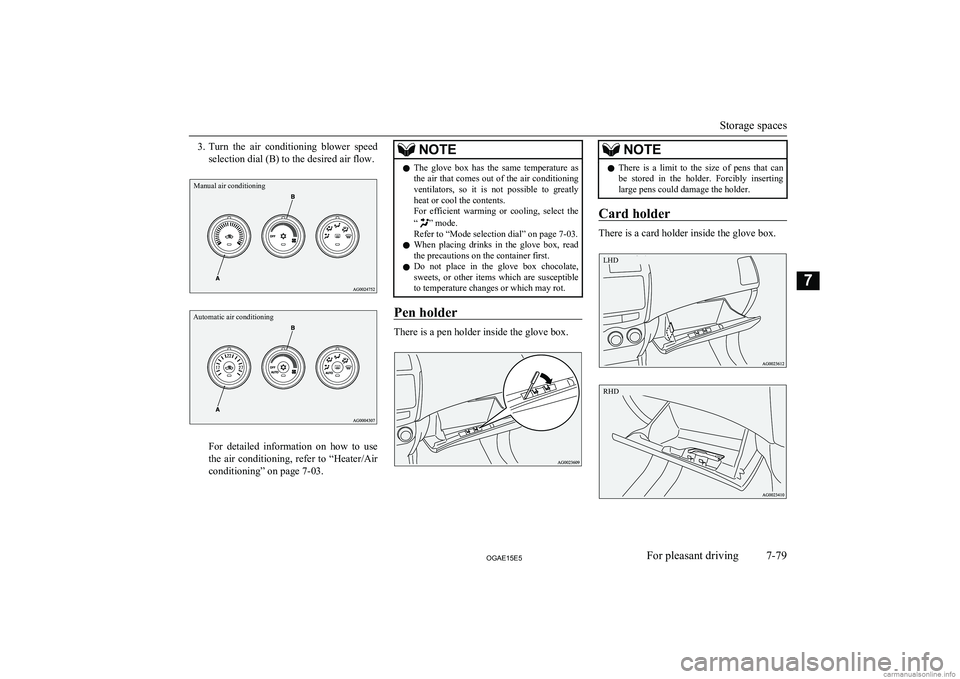
3.Turn the air conditioning blower speed
selection dial (B) to the desired air flow.Manual air conditioningAutomatic air conditioning
For detailed information on how to use
the air conditioning, refer to “Heater/Air
conditioning” on page 7-03.
NOTEl The glove box has the same temperature as
the air that comes out of the air conditioningventilators, so it is not possible to greatly heat or cool the contents.
For efficient warming or cooling, select the
“
” mode.
Refer to “Mode selection dial” on page 7-03.
l When placing drinks in the glove box, read
the precautions on the container first.
l Do not place in the glove box chocolate,
sweets, or other items which are susceptible
to temperature changes or which may rot.
Pen holder
There is a pen holder inside the glove box.
NOTEl There is a limit to the size of pens that can
be stored in the holder. Forcibly inserting large pens could damage the holder.
Card holder
There is a card holder inside the glove box.
Storage spaces
7-79OGAE15E5For pleasant driving7 LHD RHD
Page 322 of 452
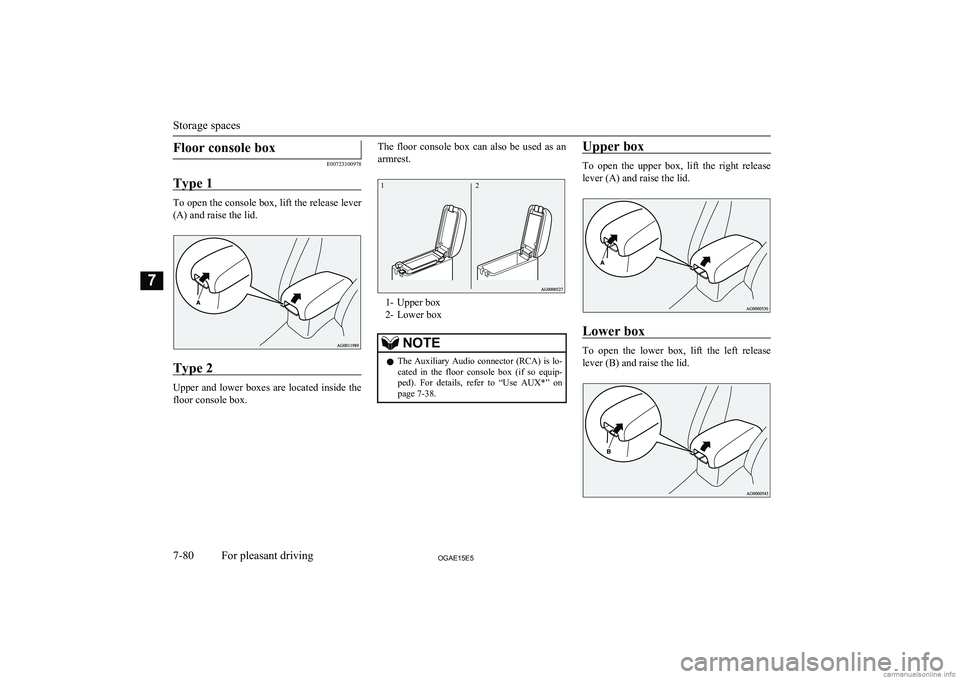
Floor console box
E00723300978
Type 1
To open the console box, lift the release lever (A) and raise the lid.
Type 2
Upper and lower boxes are located inside the
floor console box.
The floor console box can also be used as an
armrest.
1- Upper box
2- Lower box
NOTEl The Auxiliary Audio connector (RCA) is lo-
cated in the floor console box (if so equip-
ped). For details, refer to “Use AUX*” on page 7-38.Upper box
To open the upper box, lift the right release
lever (A) and raise the lid.
Lower box
To open the lower box, lift the left release lever (B) and raise the lid.
Storage spaces
7-80OGAE15E5For pleasant driving7 1 2
Page 323 of 452
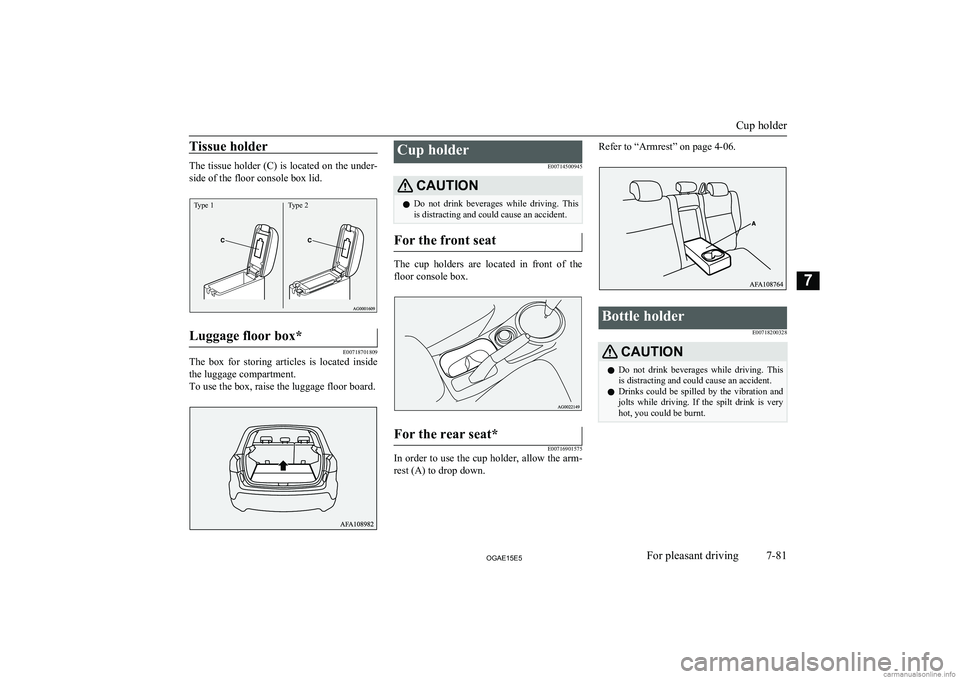
Tissue holder
The tissue holder (C) is located on the under-
side of the floor console box lid.
Type 1Type 2Luggage floor box*
E00718701809
The box for storing articles is located inside the luggage compartment.
To use the box, raise the luggage floor board.
Cup holder
E00714500945CAUTIONlDo not drink beverages while driving. This
is distracting and could cause an accident.
For the front seat
The cup holders are located in front of the
floor console box.
For the rear seat*
E00716901575
In order to use the cup holder, allow the arm-
rest (A) to drop down.
Refer to “Armrest” on page 4-06.Bottle holder
E00718200328CAUTIONlDo not drink beverages while driving. This
is distracting and could cause an accident.
l Drinks could be spilled by the vibration and
jolts while driving. If the spilt drink is very
hot, you could be burnt.
Cup holder
7-81OGAE15E5For pleasant driving7
Page 324 of 452
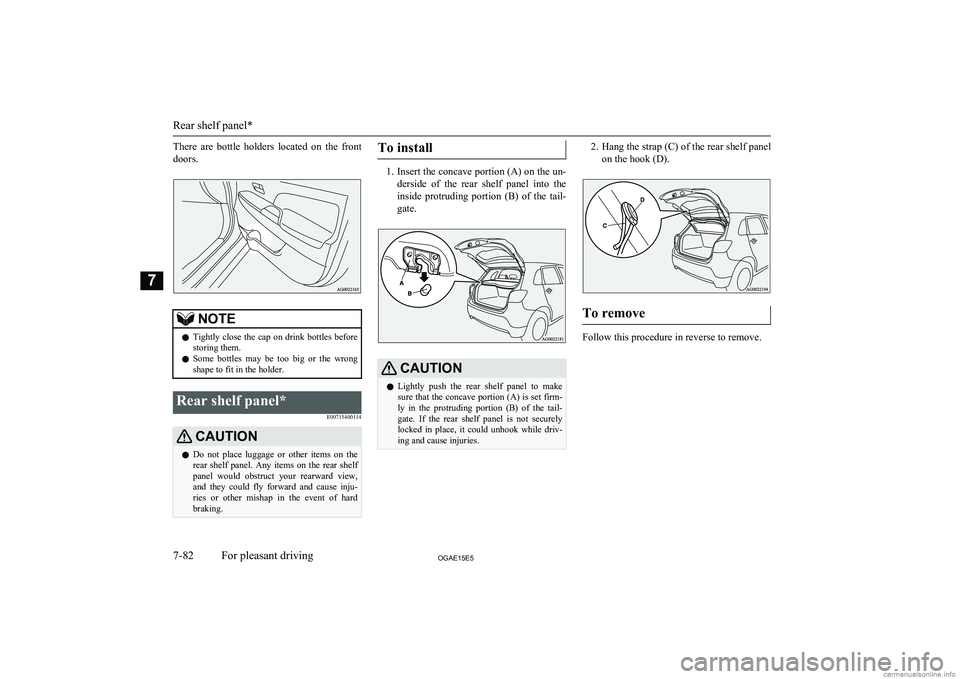
There are bottle holders located on the front
doors.NOTEl Tightly close the cap on drink bottles before
storing them.
l Some bottles may be too big or the wrong
shape to fit in the holder.Rear shelf panel*
E00715400114CAUTIONlDo not place luggage or other items on the
rear shelf panel. Any items on the rear shelf
panel would obstruct your rearward view, and they could fly forward and cause inju-
ries or other mishap in the event of hard
braking.To install
1. Insert the concave portion (A) on the un-
derside of the rear shelf panel into the inside protruding portion (B) of the tail-
gate.
CAUTIONl Lightly push the rear shelf panel to make
sure that the concave portion (A) is set firm-ly in the protruding portion (B) of the tail- gate. If the rear shelf panel is not securely
locked in place, it could unhook while driv- ing and cause injuries.2. Hang the strap (C) of the rear shelf panel
on the hook (D).
To remove
Follow this procedure in reverse to remove.
Rear shelf panel*
7-82OGAE15E5For pleasant driving7
Page 325 of 452
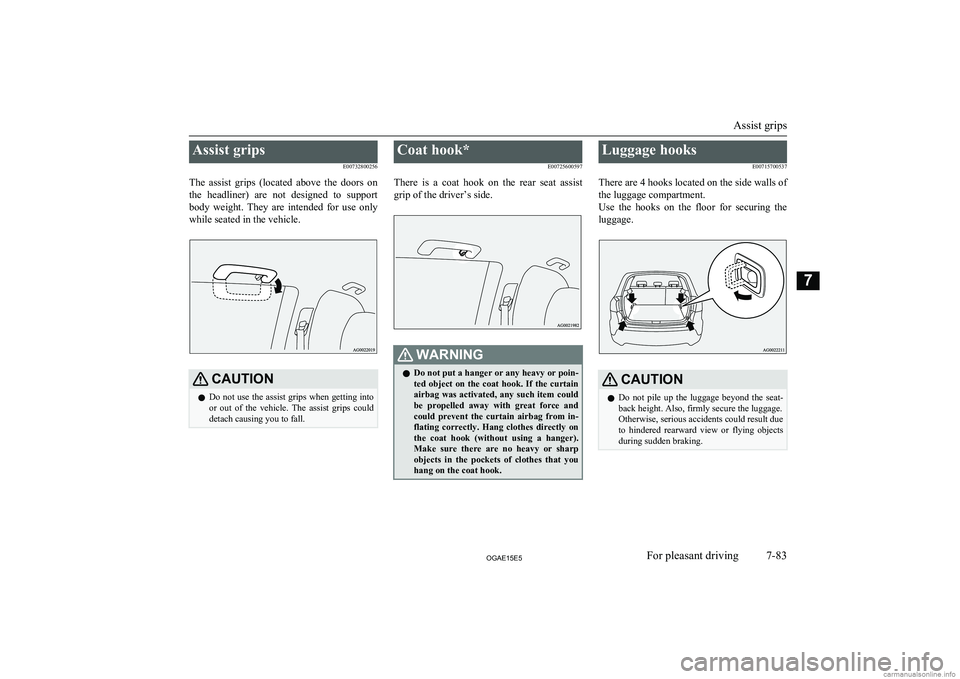
Assist gripsE00732800256
The assist grips (located above the doors on the headliner) are not designed to support
body weight. They are intended for use only while seated in the vehicle.CAUTIONl Do not use the assist grips when getting into
or out of the vehicle. The assist grips could
detach causing you to fall.Coat hook*
E00725600597
There is a coat hook on the rear seat assist
grip of the driver’s side.WARNINGl Do not put a hanger or any heavy or poin-
ted object on the coat hook. If the curtain
airbag was activated, any such item could
be propelled away with great force and could prevent the curtain airbag from in-
flating correctly. Hang clothes directly on the coat hook (without using a hanger).
Make sure there are no heavy or sharp objects in the pockets of clothes that you
hang on the coat hook.Luggage hooks
E00715700537
There are 4 hooks located on the side walls of
the luggage compartment.
Use the hooks on the floor for securing the luggage.CAUTIONl Do not pile up the luggage beyond the seat-
back height. Also, firmly secure the luggage.
Otherwise, serious accidents could result due
to hindered rearward view or flying objects
during sudden braking.
Assist grips
7-83OGAE15E5For pleasant driving7
Page 326 of 452
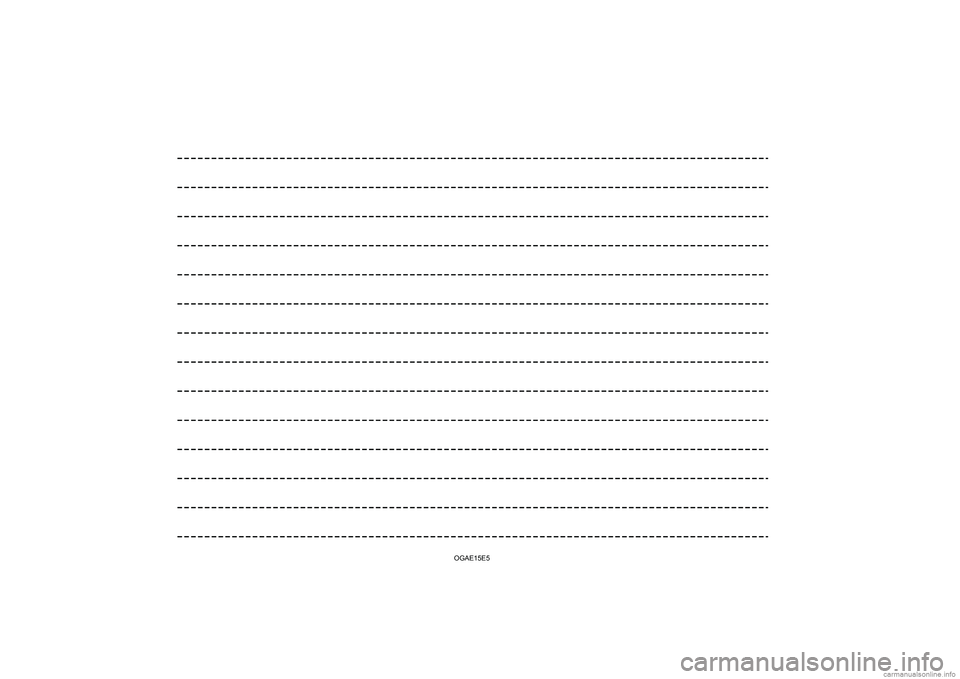
OGAE15E5
Page 327 of 452
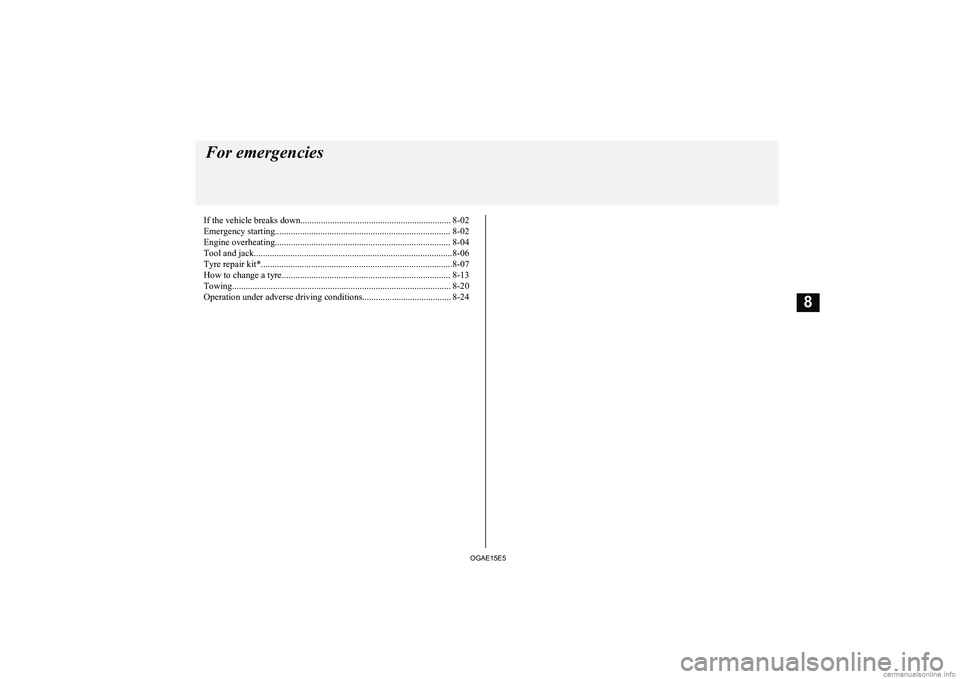
If the vehicle breaks down.................................................................. 8-02Emergency starting............................................................................. 8-02
Engine overheating............................................................................. 8-04
Tool and jack.......................................................................................8-06
Tyre repair kit*....................................................................................8-07
How to change a tyre.......................................................................... 8-13
Towing................................................................................................ 8-20
Operation under adverse driving conditions....................................... 8-24For emergencies
OGAE15E58
Page 328 of 452
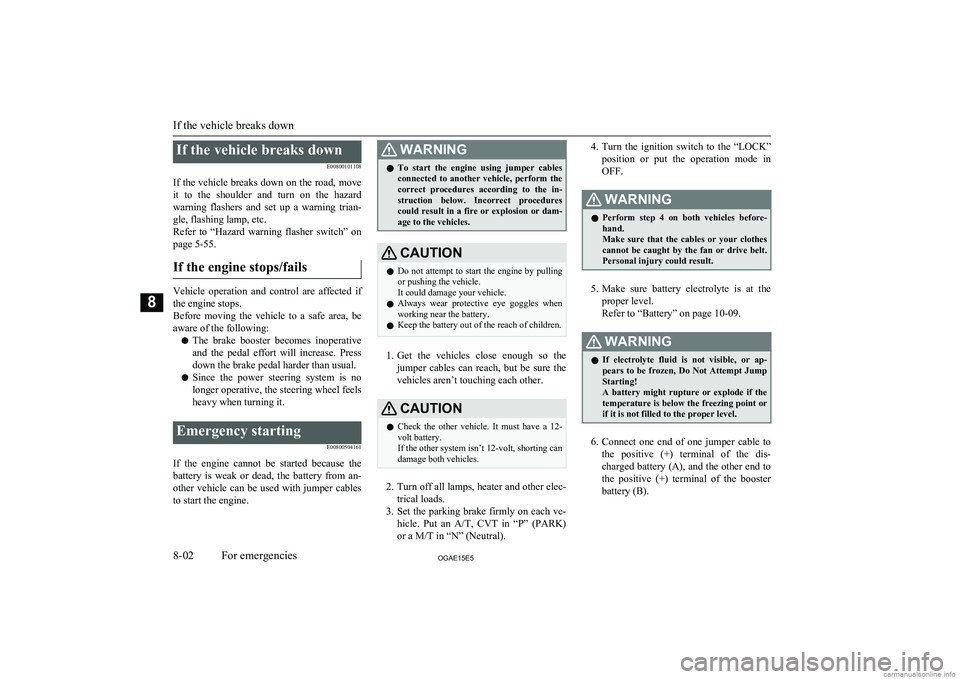
If the vehicle breaks downE00800101108
If the vehicle breaks down on the road, move it to the shoulder and turn on the hazard
warning flashers and set up a warning trian- gle, flashing lamp, etc.
Refer to “Hazard warning flasher switch” on
page 5-55.
If the engine stops/fails
Vehicle operation and control are affected if
the engine stops.
Before moving the vehicle to a safe area, be
aware of the following:
l The brake booster becomes inoperative
and the pedal effort will increase. Press down the brake pedal harder than usual.
l Since the power steering system is no
longer operative, the steering wheel feels
heavy when turning it.
Emergency starting
E00800504161
If the engine cannot be started because thebattery is weak or dead, the battery from an-other vehicle can be used with jumper cables to start the engine.
WARNINGl To start the engine using jumper cables
connected to another vehicle, perform the
correct procedures according to the in- struction below. Incorrect procedures could result in a fire or explosion or dam-
age to the vehicles.CAUTIONl Do not attempt to start the engine by pulling
or pushing the vehicle.
It could damage your vehicle.
l Always wear protective eye goggles when
working near the battery.
l Keep the battery out of the reach of children.
1.
Get the vehicles close enough so the
jumper cables can reach, but be sure the vehicles aren’t touching each other.
CAUTIONl Check the other vehicle. It must have a 12-
volt battery.
If the other system isn’t 12-volt, shorting can
damage both vehicles.
2. Turn off all lamps, heater and other elec-
trical loads.
3. Set the parking brake firmly on each ve-
hicle. Put an A/T, CVT in “P” (PARK)
or a M/T in “N” (Neutral).
4. Turn the ignition switch to the “LOCK”
position or put the operation mode in OFF.WARNINGl Perform step 4 on both vehicles before-
hand.
Make sure that the cables or your clothes cannot be caught by the fan or drive belt.
Personal injury could result.
5. Make sure battery electrolyte is at the
proper level.
Refer to “Battery” on page 10-09.
WARNINGl If electrolyte fluid is not visible, or ap-
pears to be frozen, Do Not Attempt Jump
Starting!
A battery might rupture or explode if the temperature is below the freezing point orif it is not filled to the proper level.
6. Connect one end of one jumper cable to
the positive (+) terminal of the dis-charged battery (A), and the other end to
the positive (+) terminal of the booster
battery (B).
If the vehicle breaks down
8-02OGAE15E5For emergencies8
Page 329 of 452
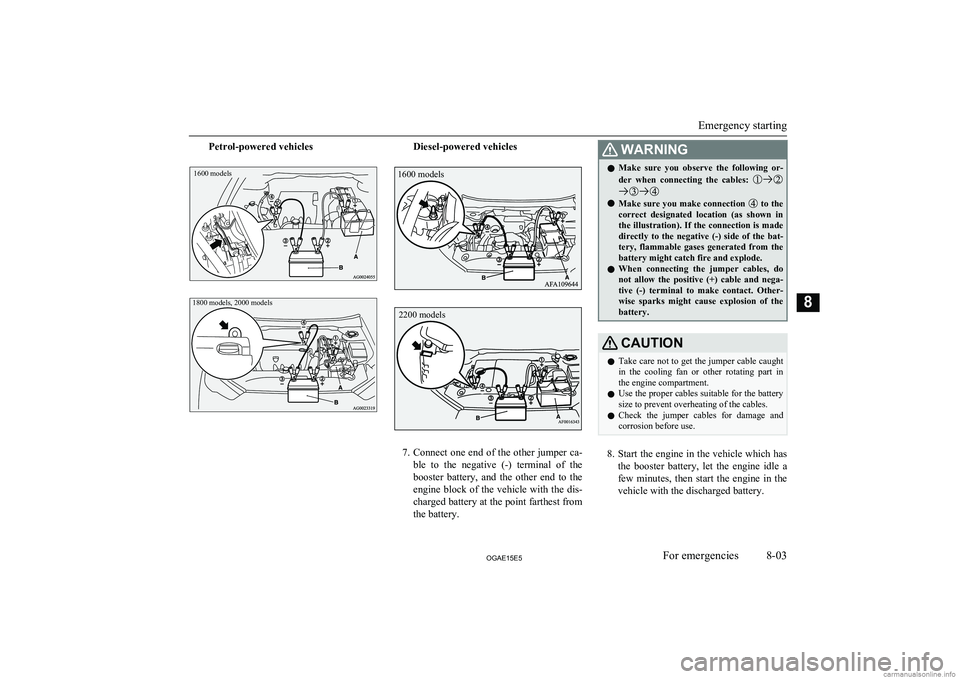
Petrol-powered vehicles1600 models1800 models, 2000 modelsDiesel-powered vehicles
7.Connect one end of the other jumper ca-
ble to the negative (-) terminal of the
booster battery, and the other end to the engine block of the vehicle with the dis-
charged battery at the point farthest from the battery.
WARNINGl Make sure you observe the following or-
der when connecting the cables:
l Make sure you make connection to the
correct designated location (as shown in the illustration). If the connection is made
directly to the negative (-) side of the bat- tery, flammable gases generated from the
battery might catch fire and explode.
l When connecting the jumper cables, do
not allow the positive (+) cable and nega-
tive (-) terminal to make contact. Other- wise sparks might cause explosion of the battery.
CAUTIONl Take care not to get the jumper cable caught
in the cooling fan or other rotating part in
the engine compartment.
l Use the proper cables suitable for the battery
size to prevent overheating of the cables.
l Check the jumper cables for damage and
corrosion before use.
8. Start the engine in the vehicle which has
the booster battery, let the engine idle a
few minutes, then start the engine in the vehicle with the discharged battery.
Emergency starting
8-03OGAE15E5For emergencies81600 models 2200 models
Page 330 of 452
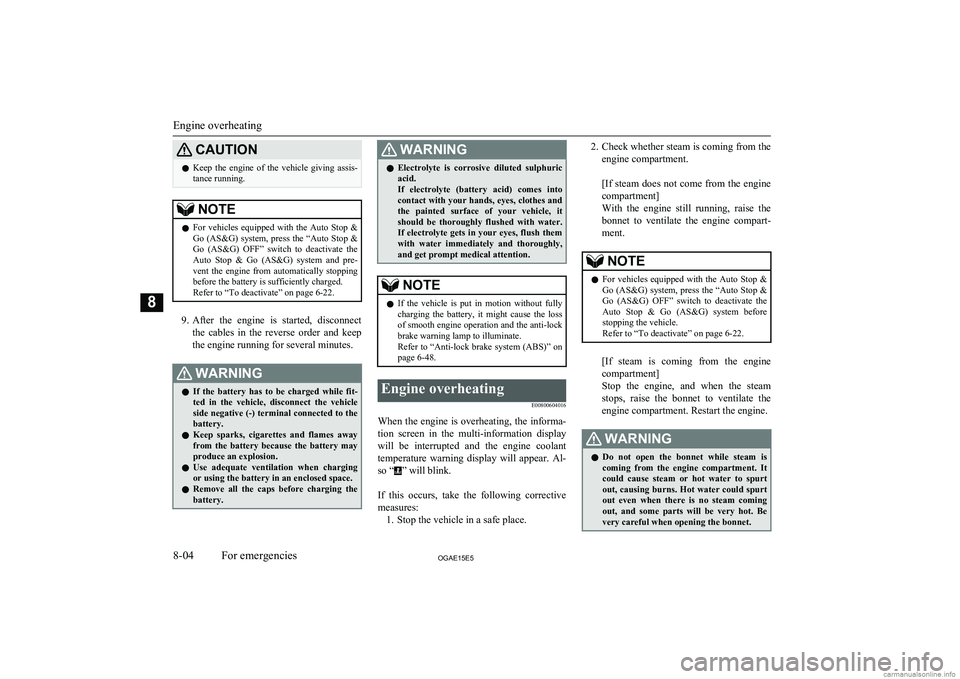
CAUTIONlKeep the engine of the vehicle giving assis-
tance running.NOTEl For vehicles equipped with the Auto Stop &
Go (AS&G) system, press the “Auto Stop &Go (AS&G) OFF” switch to deactivate theAuto Stop & Go (AS&G) system and pre- vent the engine from automatically stoppingbefore the battery is sufficiently charged.Refer to “To deactivate” on page 6-22.
9. After the engine is started, disconnect
the cables in the reverse order and keep the engine running for several minutes.
WARNINGl If the battery has to be charged while fit-
ted in the vehicle, disconnect the vehicle side negative (-) terminal connected to the
battery.
l Keep sparks, cigarettes and flames away
from the battery because the battery may produce an explosion.
l Use adequate ventilation when charging
or using the battery in an enclosed space.
l Remove all the caps before charging the
battery.WARNINGl Electrolyte is corrosive diluted sulphuric
acid.
If electrolyte (battery acid) comes into contact with your hands, eyes, clothes and
the painted surface of your vehicle, it should be thoroughly flushed with water.If electrolyte gets in your eyes, flush them
with water immediately and thoroughly, and get prompt medical attention.NOTEl If the vehicle is put in motion without fully
charging the battery, it might cause the loss
of smooth engine operation and the anti-lock brake warning lamp to illuminate.
Refer to “Anti-lock brake system (ABS)” on
page 6-48.Engine overheating
E00800604016
When the engine is overheating, the informa-tion screen in the multi-information display
will be interrupted and the engine coolant
temperature warning display will appear. Al- so “
” will blink.
If this occurs, take the following corrective measures: 1. Stop the vehicle in a safe place.
2. Check whether steam is coming from the
engine compartment.
[If steam does not come from the engine
compartment]
With the engine still running, raise the
bonnet to ventilate the engine compart-
ment.NOTEl For vehicles equipped with the Auto Stop &
Go (AS&G) system, press the “Auto Stop &Go (AS&G) OFF” switch to deactivate theAuto Stop & Go (AS&G) system before stopping the vehicle.
Refer to “To deactivate” on page 6-22.
[If steam is coming from the engine
compartment]
Stop the engine, and when the steam
stops, raise the bonnet to ventilate the engine compartment. Restart the engine.
WARNINGl Do not open the bonnet while steam is
coming from the engine compartment. It
could cause steam or hot water to spurt out, causing burns. Hot water could spurt
out even when there is no steam coming out, and some parts will be very hot. Be
very careful when opening the bonnet.
Engine overheating
8-04OGAE15E5For emergencies8